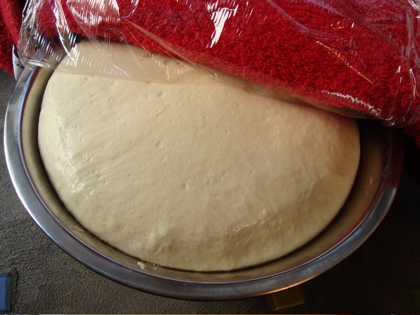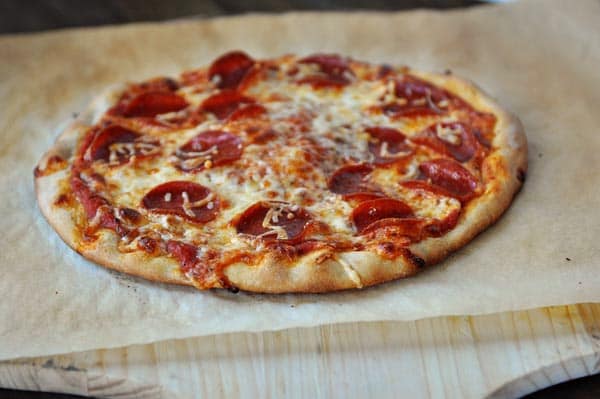Recipe For Homemade Pizza Dough Biography
source(google.com.pk)
After recently posting a collection of pizza-making tips, I bought some Pizza Tonight dough and made some of my own dough as well. Then, I made six pizzas for 20 people at my wife’s birthday party and the outcome revealed a real disparity. My competently made pizza dough couldn’t hold a candle to Pizza Tonight’s. People raved about every pizza I made with it. I put white sauce on that light and airy dough and nestled brussels sprouts and caramelized onions into it. Draped some thinly sliced ham (donated by an attendee) and added smoked mozzarella. Scattered potato slices with garlic and rosemary. Each of those pizzas, in turn, totally stole the show. I’m telling you a monkey could make amazing pizza with Pizza Tonight’s dough as the foundation. Not a bite of crust was left behind.
We won’t get into how the pizzas with my dough fared. The point is, I was just about to call it quits. Stop the exploration of every kind of pizza. And just tithe part of my paycheck to Victoria Deroche’s Pizza Tonight business. And then Doug emailed me about New Jersey tavern-style pizza. What’s this? Bar pizza? A style of pizza I’ve never heard of? His name is Doug Mulvihill, and we first corresponded in response to my La Michoacana ice cream post. Months later, he saw my pizza post and let me know that he’s got some pizza secrets of his own from several years working on his technique. Now, let me get outta the way, so Doug can tell you how he, um… rolls.
—————-
it’s all Doug from here down
—————-
I love pizza, and I think I make fairly decent pies, so hopefully I can provide some information that might help someone. Before I explain everything, I need to provide some context on my pizza history and what prompted me to make my own pies.We all have our favorite pizza. Based on what I have seen, most people become attached to the pizza of their youth. The pizza we eat as children shapes our appreciation. Generally people idealize their first pizza, and it becomes their favorite for life. None of us is wrong, we just like what we like.
I think the greatest pizza in the world is made in Orange, New Jersey, at Star Tavern. Star is famous for making a style some call “bar pizza”, which has a very thin crust and is quite popular in New Jersey (where I lived until 1990). I know that I am among many thousands of people who consider Star to be the very best pizza ever made. Although I have not had it regularly in the past 20 years, I have been eating it my whole life.
But this story begins earlier than that. My father has also been eating Star pizza for over 40 years. He lived most of his life in New Jersey, so his favorite pizza was always available to him. When he retired, he and my mother decided to move to North Carolina for a life of golf and leisure. Unfortunately, this meant that he would no longer be able to have Star pies regularly. This seemed unacceptable to my father, so he developed a novel solution. At his last visit to Star, he explained to the owner that he was moving to North Carolina and would probably not have access to good pizza. He asked the owner a simple question. “How do you do it?” Fortunately, the owner did not feel compelled to guard the secrets that made his establishment one of the most successful and famous pizzerias in the northeast. He didn’t just give my father some advice, he told him EVERYTHING. He brought my father into the kitchen and showed him all of the techniques for making ultra thin crust pizza. He gave him a few industrial sized cans of tomatoes, and wished him luck.
That was almost 15 years ago, and my father has been making New Jersey bar pizza (following the Star recipe) ever since. A few years ago, he gave me all of the necessary tools, and explained the process to me. He also taught my brother. Now we all make our version of Star pizza, using the same ingredients and same process.
That’s the back story. Now I will explain the particulars. Please refer to the footnotes for explanation, commentary, and guidance. I tried to keep the “recipe” section neutral and direct.A pizza's crust can be made using almost any dough or bread recipe. White flour is commonly used for a soft crust that won't crumble, which is usually considered desirable. Whole wheat flour can be used to make a firmer crust. Cake flour can be useful if a crumbly crust is desired. Other common ingredients in crusts include Olive oil (usually extra virgin), active dry yeast, sugar, and salt. Less often crusts will include ingredients like malt-syrup, vital wheat gluten, and various dough activators to help the yeast ferment and the crust to brown while baking. What type of crust to use is matter of taste.
There are several types of pizza crust that are constructed differently and have (sometimes) wildly different textures, though the taste remains fairly consistent. The most common styles are Neapolitan, thin, New York-style, deep dish, Sicilian, and pan pizza crust.
There are many different techniques for preparing dough, most largely dependent on the type of crust you've decided to make. Because pizza crusts almost always contain yeast they must be allowed to rise at least once, though some recipes recommend improving the flavor and texture of the dough by allowing the crust to rise 2 separate times. Higher quality recipes also often recommend that you deflate the dough after the first rise and refrigerate it overnight to help improve its flavor and texture. Depending on the recipe dough docking or pre-baking might be necessary as well.
thin-crust pizza without precooking the crust
deep dish pizzaPizzas are typically baked directly on special surfaces for short periods at temperatures in excess of 500 degrees F (260 degrees C).
Coal and brick ovens are preferred for baking pizza because of their even heat and superior heat-retention. Some pizzerias prefer to use a wire-mesh pan though, as working with pizza peels can be difficult for some.
Home bakers can attempt to duplicate the effects of a brick oven by using a baking stone (also called a pizza stone), a slab of porous stone that evenly heats the pizza and leeches moisture away from the dough, helping it develop a better crust. Baking/pizza stones become "seasoned" after frequent use, a characteristic that is said to improve the flavor of crusts baked on them.
Recipe For Homemade Pizza Dough


Recipe For Homemade Pizza Dough


Recipe For Homemade Pizza Dough


Recipe For Homemade Pizza Dough


Recipe For Homemade Pizza Dough


Recipe For Homemade Pizza Dough


Recipe For Homemade Pizza Dough


Recipe For Homemade Pizza Dough


Recipe For Homemade Pizza Dough


Recipe For Homemade Pizza Dough


No comments:
Post a Comment